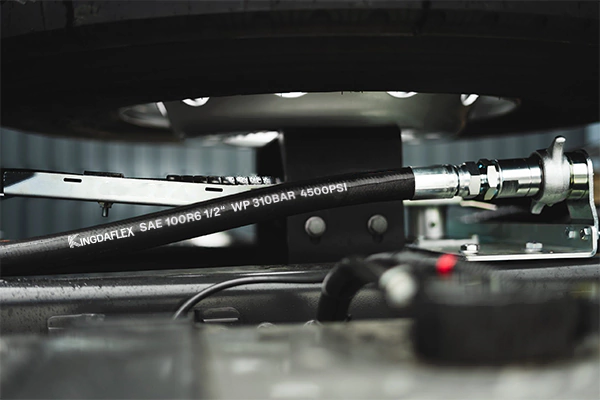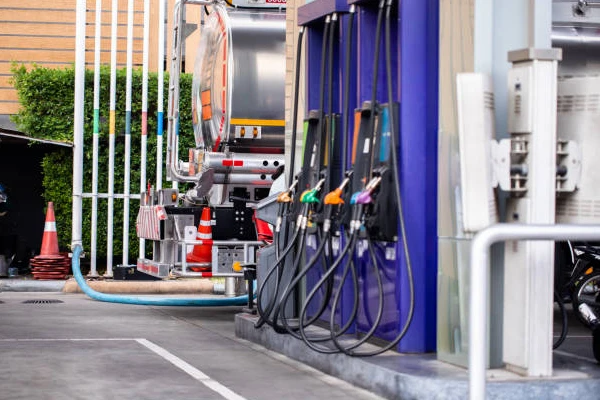When you’re preparing hydraulic hoses for shipping, proper packaging is crucial for protecting them from damage and ensuring they arrive safely. This guide outlines five effective methods for packing hydraulic hoses, including the popular weaving belt and transparent PE film, as well as the benefits of using wooden pallets and reels.
Choosing the right packaging method depends on your specific needs, balancing protection with cost and convenience. Whether you prioritize maximum durability with a wooden box or a more economical solution like a weaving belt, understanding these options will help you make an informed decision for safe and efficient transport.
What Hydraulic Hose Is Used for?
![How to Pack Hydraulic Hose? [5 Useful Packaging Methods] 1 hydraulic hose application situations](https://kingdaflex.com/wp-content/uploads/2021/10/hydraulic-hose-application-situations--1024x576.webp)
Hydraulic hoses are flexible conduits designed to transmit fluid power between different components in a hydraulic system. They are crucial for moving hydraulic fluids—typically oil, water, or other liquids—under immense pressure to power machinery and equipment. Their reinforced, multi-layered construction allows them to withstand high-pressure, high-temperature, and often abrasive operating environments.
- Heavy Machinery: Hydraulic hoses are indispensable for construction equipment like excavators, loaders, and cranes, where they enable critical functions such as lifting, digging, and steering.
- Agriculture: In farming, they are used on tractors, harvesters, and other machinery to power hydraulic systems that operate implements like loaders and spray booms.
- Industrial & Automotive: They are also used in manufacturing for presses and robotics, and in vehicles for systems like power steering and braking, ensuring safe and reliable performance.
How to Pack Hydraulic Hoses
To pack hydraulic hoses, you should clean and cap the hoses, coil them properly, and secure the coils. Next, you need to choose the appropriate packaging material, such as boxes, crates, or bags, based on the size, quantity, and destination of the hoses. Finally, label the package clearly to ensure correct handling and delivery.
Weaving Belt for Hydraulic Hose Packaging
![How to Pack Hydraulic Hose? [5 Useful Packaging Methods] 2 woven bag for hydraulic hose packaging](https://kingdaflex.com/wp-content/uploads/2021/10/woven-bag-for-hydraulic-hose-packaging.jpg)
A weaving belt, often referred to as a woven bag or protective sleeve, is a popular packaging method for hydraulic hoses during shipping. This method involves encasing the coiled hose in a strong, woven material, typically polypropylene or similar synthetic fibers. The belt is designed to be durable and resistant to tears, punctures, and abrasion, which are common risks during transit.
It’s often applied using an automated machine that tightly wraps the material around the coiled hose, creating a secure and compact package. The primary purpose of the weaving belt is to protect the hose from external damage and keep it in a neat, coiled shape to save space and simplify handling.
The use of a weaving belt offers several advantages for packaging hydraulic hoses. It’s a cost-effective solution that provides excellent protection without the bulk of a wooden crate or the added weight of a plastic reel. The tight wrap of the weaving belt helps to prevent the hose from unraveling or kinking, which could compromise its integrity.
While some may argue that the non-transparent nature of the belt makes it difficult to see the hose inside, this method is highly favored for its protective qualities and efficiency in maximizing container space during shipment.
The automated hydraulic hose packing machine can work out for the hydraulic hose packaging process, and the weaving belt is super protective, but it is a little harder for you to recognize the hydraulic hose inside. You need to open the packaging and then know the hydraulic hose look. And we can make the stickers to paste on the surface of the wrapped hydraulic hose to tell you what is inside.
![How to Pack Hydraulic Hose? [5 Useful Packaging Methods] 3 hydraulic hose packing machine](https://kingdaflex.com/wp-content/uploads/2021/10/hydraulic-hose-packing-machine.jpg)
Our hydraulic hose manufacturer has the hydraulic hose packing machine to wrap the hydraulic hose with the weaving belt or PE film, and the hydraulic hose packing machine is the must-have tool to wrap the hydraulic hose.
PE Film for Hydraulic Hose Packaging
![How to Pack Hydraulic Hose? [5 Useful Packaging Methods] 4 pe plastic film for hydraulic hose](https://kingdaflex.com/wp-content/uploads/2021/10/pe-plastic-film-for-hydraulic-hose.jpg)
PE film is a popular and cost-effective method for packaging hydraulic hoses, particularly for coiled lengths. This method involves using a machine to wrap the coiled hose in multiple layers of polyethylene (PE) plastic film, creating a tightly sealed and protective package.
The PE film provides an excellent barrier against moisture, dust, and dirt, keeping the hose clean and ready for use. It also helps to prevent abrasions and minor surface damage that can occur during shipping and handling. For companies that need to package a large volume of hoses, this process can be automated, with specialized wrapping machines designed to efficiently wrap the coils in a spiral manner.
Here is the video below showing you how to pack the hydraulic hose using the PE film.
These two packaging methods are recommended because weaving belt and PE plastic film is cheap, and we can put more hydraulic hose rolls in a container as much as possible, and we can put the hydraulic hose in the gap to save space for the shipping container.
![How to Pack Hydraulic Hose? [5 Useful Packaging Methods] 5 hydraulic hose loaded](https://kingdaflex.com/wp-content/uploads/2021/10/hydraulic-hose-loaded.jpg)
We recommend you to pack the hydraulic hose using the weaving belt or PE plastic film to save the shipping cost, and it’s also the reason why this packaging method is the most popular.
Hydraulic Hose Weaving Belt with Wooden Pallet
![How to Pack Hydraulic Hose? [5 Useful Packaging Methods] 6 hydraulic hose weaving belt with wooden pallet](https://kingdaflex.com/wp-content/uploads/2021/10/hydraulic-hose-weaving-belt-with-wooden-pallet.jpg)
And you also can choose to place the wrapped hydraulic hose rolls on the wooden pallet, and wrap the wooden pallet together. It is much more convenient for you to store the hydraulic hoses in your warehouse, and also convenient to load and unload the hydraulic hose at any time when you need.
You can choose this packaging method to help you save much time during the cargo loading process, but you cannot pile the hydraulic hose in the gap because the wooden pallet is square, and the hydraulic hose is wrapped together with a wooden pallet, becoming an integral whole.
Reels for Hydraulic Hose Packaging
![How to Pack Hydraulic Hose? [5 Useful Packaging Methods] 7 hydraulic hose reel](https://kingdaflex.com/wp-content/uploads/2021/10/hydraulic-hose-reel.jpg)
Reels are an excellent method for packaging and storing hydraulic hoses, especially for large, continuous lengths. A reel is a cylindrical drum, typically made of metal or wood, around which a hose is wound. This method is particularly useful for suppliers and end-users who need to store and dispense long hoses in an organized manner.
The reel prevents the hose from kinking, twisting, or becoming tangled, all of which can damage the hose’s internal structure and reduce its service life. The wound hose can be secured with straps or bands to keep it from unraveling during transport. This method provides superior protection and ensures the hose maintains its correct curvature.
![How to Pack Hydraulic Hose? [5 Useful Packaging Methods] 8 hydraulic hose reels](https://kingdaflex.com/wp-content/uploads/2021/10/hydraulic-hose-reels.jpg)
Using reels for hydraulic hose packaging offers several key advantages. It provides a safe and efficient way to store and transport hoses, as they are kept off the floor and away from potential hazards. Reels make it easy for customers to handle and unspool the exact length of hose they need without having to untangle a messy coil.
This not only saves time but also reduces waste. While reels can be more expensive and take up more space than other packaging methods like a weaving belt or PE film, they are a worthwhile investment for applications where hose integrity, organization, and ease of use are priorities.
Wooden Box for Hydraulic Hose Packaging
![How to Pack Hydraulic Hose? [5 Useful Packaging Methods] 9 wooden box for hydraulic hose packaging](https://kingdaflex.com/wp-content/uploads/2021/10/wooden-box-for-hydraulic-hose-packaging.jpg)
A wooden box is one of the most robust and secure packaging methods for hydraulic hoses, particularly for heavy-duty, long, or high-value hoses. This method involves carefully placing the hose coils or straight lengths inside a custom-built wooden crate. Wooden boxes offer unparalleled protection against external damage, such as punctures, crushing, and harsh environmental conditions during transit.
The interior of the box can be lined with padding, foam, or custom-fit supports to prevent the hoses from shifting and to protect the fittings from impact. This packaging method is often used for international shipments or when the hoses are being transported alongside other heavy machinery, where durability is a primary concern.
While a wooden box provides the best protection, it is also one of the more expensive and heavy packaging options. The added weight of the wooden crate can increase shipping costs, and the box itself may be subject to international regulations, such as ISPM 15, which requires wood packaging to be treated to prevent the spread of pests.
However, for a manufacturer shipping a large number of hoses to a single destination or for delicate, pre-formed hose assemblies, the superior protection of a wooden box often outweighs the higher cost and logistical complexities. It ensures the product arrives in pristine condition, reducing the risk of returns or warranty claims due to transit damage.
How to Choose Suitable Hydraulic Hose Packing Methods
To choose a suitable hydraulic hose packaging method, you must consider the hose’s specific needs, the shipping environment, and cost. The best method strikes a balance between protecting the hose from damage and being economically viable for the shipment.
- Hose Type and Length: For coiled hoses, methods like PE film or weaving belts are ideal for their cost-effectiveness and ability to secure the coil. For long, straight hoses that can’t be coiled, wooden boxes provide the necessary length and rigidity for protection.
- Shipping Distance and Handling: For local or national shipping, where handling is predictable, a pallet or bulk spool is often sufficient. However, for international shipping or rough handling, a sturdy wooden box is a better choice to prevent crushing or punctures.
- Cost and Visibility: PE film and weaving belts are the most cost-effective options and maximize space, which reduces shipping costs. However, if you need to see the hose without unwrapping, the transparency of PE film is a significant advantage over an opaque weaving belt.
Conclusion
In conclusion, proper packaging of hydraulic hoses is crucial for their integrity and performance. The choice of method, from PE film to wooden boxes, depends on the hose type, shipping conditions, and cost. Each approach ensures hoses arrive in perfect condition, ready for immediate use.
The variety of solutions allows for a tailored approach. PE film is cost-effective and transparent, while a weaving belt offers tough abrasion resistance. Reels provide convenience for long lengths, and a wooden box offers ultimate protection against all transit damage.
For businesses needing high-quality hydraulic hoses, Kingdaflex provides expertly packed products. Contact Kingdaflex today to get a quote on wholesale hydraulic hoses, ensuring your products arrive in pristine condition, built to last.




